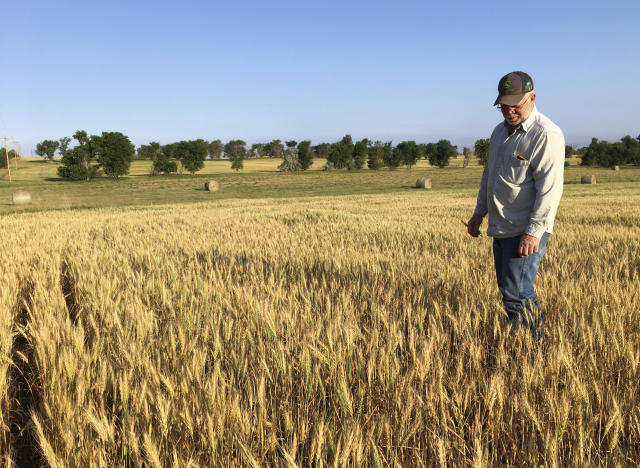On a warm summer morning in Stewart, Ohio, a school bus staffed by a handful of AmeriCorps service members and several people from the local school district descend on the lawn of a community resource center. The yellow bus has been retrofitted with shelves and coolers that house fresh eggs, produce, and pantry staples.
A woman named Tisha, a resident in her early 40’s who says that she lives “on top of the ridge” in nearby Guysville, and her nine-year-old daughter approach in a small red SUV. They get out, greet the staff heartily and embark the bus, selecting eggs, a slew of fresh produce, as well as crackers and a few other shelf-stable foods.
 On the Summer Food Bus. (Photo credit: Federal Hocking Local Schools)
On the Summer Food Bus. (Photo credit: Federal Hocking Local Schools)
“Vegetables are so expensive, I’d rather get them somewhere like this,” says Tisha, who visits the bus weekly. She asks for two boxes to be made up; one for her own family and another for a family who couldn’t make it over that morning, thanks to a broken-down car.
It is this marker of rural poverty—lack of or limited transportation—that led George Wood, the district’s superintendent, to conceive of the food bus model three years ago. In a massive rural district covering more than 190 square miles, food pantries serve as a lifeline to many of the families living in this part of the Appalachian foothills. But they haven’t always been easy to access. “Many people don’t have working cars and there’s no mass transit here,” says Wood.
Though summer lunch programs are staged at public libraries and town halls throughout the region, Wood knows that some families can’t access them frequently due to transportation struggles.
Stewart is in Athens County, which is statistically the most food insecure county in Ohio, with nearly 1 in 5 residents lacking sufficient access to nutritious and affordable food. For children, the rate is 24 percent, or nearly 1 in 4. (That’s compared to 1 in 8 people nationwide.)
In Athens County, the poverty rate is over 30 percent, the highest in the state. Ten other counties in Appalachian Ohio have poverty rates over 20 percent, making the region the poorest in Ohio.
Seventy-five percent of the nation’s food-insecure counties reside in rural settings. According to Feeding America, 2.4 million U.S. rural households lack sufficient access to nutritious and affordable food. Like Appalachian Ohio, many of these regions are rich in natural assets or farmland that benefit industrial powers elsewhere.
The school system’s Summer Food Bus offers groceries free to any resident in the district with children. On Tuesdays, the bus travels to three stops in the western part of the district and on Fridays, it visits three in the east. The goal is to ease residents’ transportation burdens by getting as close to them as possible. Jake Amlin, assistant superintendent for student services at the district and the on-the-ground leader of the effort, brings food directly to a few families’ homes each week.
 The party atmosphere outside the Summer Food Bus. (Photo credit: Federal Hocking Local Schools)
The party atmosphere outside the Summer Food Bus. (Photo credit: Federal Hocking Local Schools)
At each distribution site, the team puts up a tent, tables, and chairs and sets up a cornhole game, soccer balls, and hula hoops to help create a party atmosphere. “I want kids to want to come here,” Amlin says in reference to the games, art supplies, books, and staff ready to engage. “I think it will erode some of the stigma of going to get food if you’re coming to a party.” There are no limitations on how much food each family may take.
Appalachia in Need
Appalachian Ohio’s 32 counties—the state’s contribution to the central Appalachian corridor, a political, economic, and cultural hub that also includes parts of Kentucky, Tennessee, West Virginia, Virginia, and North Carolina—are visually striking. On a warm summer day, deep green, hilly vistas with vast swaths of temperate forest consume the landscape.
A drive through the winding scenery takes one through not only thick forestland but also small market gardens, livestock operations, and rural homesteads. The industries of coal, timber, and more recently hydraulic fracturing, have defined the culture here.
“This part of the state has always been very different from the rest of Ohio,” says Leslie Schaller, director of programs at the Appalachian Center for Economic Networks (ACEnet), a community-based economic development organization serving Appalachian Ohio. “Part of it is geography; part of it is economic dependence on outside industry that came into the region and was extractive in every sense of the term.”
With the decline of American coal and a hemorrhaging of industrial employment in the region, the 20th century began a period of extensive emigration, with “hillbilly highways” carrying millions of souls in search of opportunity elsewhere. Some families stayed, as did their poverty, making the economic realities of a portion of today’s citizens a complicated force with a firm grip that is much more difficult to escape.
Route 33, a central corridor in the Ohio foothills, is dotted with billboard after billboard advertising drug addiction treatment services, a reminder of the rampant opioid addiction that has swept across America’s rural communities.
In the village of Coolville, Ohio, another stop on the Summer Food Bus route, a Main Street with a handful of relatively forlorn 19th-century structures demonstrates the village’s long-gone heyday as a gristmill town.

Shrivers Pharmacy Country Fresh Stop in Nelsonville, Ohio. (Photo credit: Rural Action)
For the nearly 500 current residents, the nearest full-service grocers are roughly 20 miles away in the cities of Athens and Belpre. Though the dollar store and gas station sell some food, fresh produce is in rare supply, making programs like the Summer Food Bus a lifeline for many residents.
At the town’s health clinic, a group of AmeriCorps members man a small produce stand several times a week, part of Rural Action’s Country Fresh Stops program. Rural Action is a membership-based economic development nonprofit working in all of Ohio’s Appalachian counties. Country Fresh Stops provide fresh produce to nearly a dozen stores, convenience shops, gas stations, and roadside stands in towns and villages like Coolville that need it the most.
Signs of food need are prominent at the clinic: Next to the fresh produce pop-up sits a blessing box filled with pantry staples; at the entrance to the parking lot is a sign advertising the summer feeding program for county youth hosted at the Village Hall on Main Street.
According to Lori Boegershausen, one of the AmeriCorps members, nearly 50 percent of visitors rely on produce vouchers issued from the clinic nearby to purchase product. Offered through Wholesome Wave, a national nonprofit, the program allows healthcare providers in underserved, low-income communities to prescribe fresh produce as part of a range of treatment plans.
Flora Vieland, a Coolville retiree who works part-time at the Village Hall, has a firsthand view of the dire food need in her community. She helps administer the summer feeding program and she has organized pop-up food pantries in the community.
Vieland is also a frequent visitor to the Country Fresh Stop at the clinic where she uses the vouchers. “I’m pre-diabetic,” she says explaining why a healthy diet is important. “It’s wonderful to see fresh produce available to people here. People here need stuff like that. I raised three kids by myself and I know the struggle.”
Rebuilding Robust Local Food Chains
On an early June day at the Chesterhill Produce Auction, operated by Rural Action on a winding country road in Morgan County, there’s a bustle of activity around rows of produce fresh from the field. Nearby, potted plants wait for their turn under the hum of the auctioneer. Launched in 2005, the auction (pictured at top) convenes several times a week from May to October.
Tom Redfern, Rural Action’s director of sustainable agriculture and forestry and organizer of the endeavor, points to several individuals in the crowd who are buying food for what he calls “demand networks,” or groups of consumers, businesses, and institutions that are at the heart of the farm-to-table movement in the region. It is these networks, he says, that have made the auction a success and which his team works tirelessly to cultivate. One example is Ohio University, whose Culinary Services program began buying produce at the auction for its 20,000 students in June.
Seated on folding chairs around rows of produce are Farm to School AmeriCorps members procuring for nearby K-12 institutions including the Summer Food Bus. Workers raise hands to bid on product for Country Fresh Stops, as do buyers for consumer produce clubs, restaurants, and food businesses in the region.
Unlike much of Ohio’s current farmland, where corn and soybeans consume large, flat parcels of earth, Appalachian Ohio is a rooted in small-scale, diversified agriculture on patches of land interspersed between forest. In Appalachia, the average farm operates on less than 200 acres, while nationally this figure skews toward more than 400.
Public and private organizations working in the region are increasingly eyeing the area’s rich terrain, traditional foodways, and native plant products as an economic development lever for citizens living there, all while taking into consideration the area’s unsavory extractive past to ensure that the power structures controlling and profiting from the land’s bounty are rooted in local ownership and economic networks.

ACEnet client Pork & Pickles working at the Athens Food Ventures Center. (Photo credit: ACEnet)
At ACEnet’s Athens Business Incubator Campus, the sounds of a crew at work in a commercial kitchen echo in the building’s corridor. The kitchen is part of the organization’s Food Ventures Center, which helps local food entrepreneurs to bring artisan products to market. With a central kitchen, thermal processing room, and storage warehouse, the facility was one of the first of its kind in the U.S. when it launched in 1996.
In nearby Nelsonville, Ohio, ACEnet also runs a 94,000-square-foot Business Center and Food Hub. The local produce, eggs, and meat making its way into kitchens like these is increasingly sourced from the Chesterhill Produce Auction. Many of the products coming out of these spaces then make their way to a robust, nearly 50-year-old farmers’ market held twice a week in downtown Athens. Others can be found on the shelves of grocers and the menus of eateries around the state.
Back at the auction, all goods are logged by a clerk and displayed in aggregate on the space’s main floor. Bidders—consumers, representatives of local institutions, restaurants, and business—surround the bounty. An auctioneer and his team move swiftly through the options—palettes filled with cucumbers, cabbage, beans, and other freshly grown food—offering a sale to the highest bidder who pays at a booth in the back of the building. Almost any quantity is for sale, from a single pound or pint up to an entire day’s supply.
Nationally, produce auctions have grown in recent decades as a mechanism for small and medium-sized growers from rural communities to reach wholesale buyers. There is minimal transportation, packaging, and marketing costs for growers at auction compared to some other retail outlets. However, there are risks too: The auction is absolute—meaning the seller agrees to sell everything regardless of price and some weeks are better than others. Also, by participating, producers agree to pay a small commission for the auction’s operating budget—last year, it was 16 percent.
“Most produce auctions are in the millions [of dollars] because they have big communities they serve,” Redfern says about similar initiatives across Ohio and nearby states, many of which are centered in rural towns that lie between populous urban centers.
Redfern is a respected expert in the region. A graduate of nearby Hocking College and Ohio University, he’s devoted his career to agriculture and plant care, having spent the last 15 years at Rural Action and 20 years prior in the horticulture industry. Early in his career, he was a Peace Corps volunteer, helping to develop an agroforestry curriculum for a government agency in Kenya. On the board of several Ohio entities working to advance sustainable agriculture, Redfern has seen many a scenario for production in his state. However, in conversation, his optimism for the auction model is obvious and palpable.
Figures from Rural Action that plot the Chesterhill Produce Auction’s growth support Redfern’s confidence. In 2010, the auction netted $60,000 in sales; last year, that number rose to $305,000. In 2018, the auction included 190 sellers from Ohio as well as 6 counties in West Virginia. Redfern’s team reports that $1.7 million dollars have passed to the region’s farmers through the auction over the last 10 years.
“We’ve seen investment from some of our educational institutions that really want to make Farm to School work,” Schaller says later about growing institutional demand that is helping to grow the auction model.
Behind the scenes there is a complex, yet coordinated, web of actors devoted to making it “work” for these groups. In prep kitchens at the Southeast Ohio Foodbank & Regional Kitchen and Hocking College, product purchased at the auction is delivered by Rural Action for culinary students, national service members, and volunteers to process. When school is in session, the food makes its way to cafeterias for quick consumption. During the summer, it is frozen at ACEnet’s food center in Nelsonville for use later in the year. Many schools have also welcomed garden and nutrition programming to their curriculum from area nonprofits like Community Food Initiatives and Live Healthy Appalachia.
Community at the Heart of the Narrative
Some of the farmers at the Chesterhill Produce Auction come from nearby Amish communities. One Amish farmer, Ura Heshberger, lives across the road and says that he sells 95 percent of the produce he grows on his property at the auction. Last year, Heshberger notes, he earned $15,000 to $20,000 in sales here, which, along with woodworking and cattle, helped to support his large family. For Hershberger, the auction model is preferable to a farmers market, even though product nets a higher return at the latter. At the auction, Heshberger doesn’t have to account for the cost of marketing, getting to a city market, and managing leftover product. At Chesterhill, he says his only obligations are dropping off produce and collecting the money owed to him from the organizers.
“School Day” at the Chesterhill Produce Auction. Photo Credit: Community Food Initiatives.
The Chesterhill site also hosts monthly livestock and woodcraft events. There’s a cooling unit for storing produce and a freezer to hold meat offered in the onsite store. Children roam the market with food and drink in hand. Community potlucks are held several times every season.
Another Amish producer, Warren Fussner, says that before he retired, he consistently brought what he grew to auction. Now, he only occasionally brings extra crops from his home garden about six miles away. Today, he brought eggs and a few butchered broilers but mostly he’s there to socialize. “It’s a great benefit for the community,” he says.
Dave Fisher traveled to the auction on a warm summer afternoon from his commercial raspberry operation outside of Stockport, Ohio. After starting his berry farm 10 years ago, he was put on waiting lists for farmers’ markets in the region. He brought his product to auction in the meantime, and the influx of cash helped grow his fledgling business immensely. Although he mostly sells at farmers’ markets now due to the often-higher retail price, he attends the auction regularly to buy the other ingredients he uses in value-added products like jam.
Lori Gromen stands tall in the crowd, frequently raising her hand to engage with the auctioneer. Redfern points her out, noting she’s there to purchase a whole lot of fresh food for a buyer’s club from the city of Athens’ west side. Gromen has attended the auction on behalf of the club for five years, and today, she is buying food for 30 families affiliated with the group. At the day’s end, she loads a giant red pickup with an impressive bounty.
Another buyer, Becky Clark, is on the lookout for fresh food for her pickling company, as well as the food truck and a restaurant where she’s the executive chef. Clark says the auction allows her to buy local vegetables at near-wholesale prices. “We really want volume but to still be able to work with local farmers as much as possible,” Clark says.
Making a Profit on Traditional Appalachian Foodways
Like many farmers in Appalachia, Rick and Jan Felumlee began growing food in a commitment to self-sufficiency. But unlike most, they’ve been doing so inside their five-acre woods.
“The woods were what we had,” Rick says during a break in early summer harvesting on the property. The Felumlees started the fledgling forest farm in 2017, which is supplemented by Jan’s day job at a large insurance company in central Ohio.
“Once we started learning about the plants [such as ramps and ginseng] and their threatened status in the wild, their history in the region, and how they are harvested and used, we decided that we wanted to make the land that we have productive,” Felumlee says about his wooded property.
 Wild Ramps bundled for sale at the farmers’ market. (Photo credit: Mayapple Farms)
Wild Ramps bundled for sale at the farmers’ market. (Photo credit: Mayapple Farms)
The Felumlee’s efforts are supported by Rural Action’s forestry program, which focuses on cultivating a sustainable approach to timber extraction practices—a longtime Appalachian industry. With partner organizations like United Plant Savers and the Appalachian Beginning Forest Farmer Coalition, Rural Action is increasingly working with landowners to identify and develop alternative income streams for the management of their properties. Forest farming is at the top of their list. The organization has distributed 800 pounds of seeds and bulbs that will allow farmers to grow ginseng and ramps in the region, adding nearly $1 million in potential income to woodland cultivators.
Ginseng, an ancient botanical with great demand in Asian medicine, features valuable roots with the potential to net hundreds of dollars per pound. This has resulted in extensive overharvesting of the wild variety in Appalachia. Like ginseng, ramps have grown wild in the Appalachian landscape for centuries. One of the first plants of spring, ramps are a vitamin-infused allium that are popular with consumers and chefs, and the plant has faced considerable stress in recent decades.
In addition to American ginseng, Felumlee cultivates goldenseal, black cohosh, blue cohosh, bloodroot, red trillium, and false unicorn under his trees’ canopy. He also harvests wild ramps and cultivates several varieties of mushrooms on the property, in addition to sun-loving produce.
According to Felumlee, by purposefully planting native, threatened plant populations, growers like him can ease market demand for the wild versions of these species. He is entranced by the knowledge of Appalachian growers and foragers generations before who understood the power native woodland crops hold in food and medicine, largely forgotten in recent history.
Other growers have taken note of the unusual things at Mayapple Farms’ farmers’ market stand, which Felumlee says he uses as an educational opportunity. “I tell conventional farmers that adopting forest farming on woodlots, which they generally consider unusable land, is a nice way to add a layer of diversity to their operation.”
Back at the Chesterhill Produce Auction, Tom Redfern points to a patch of rolling farmland with green crops sprouting from the soil, the site of a farm incubator for new and beginning farmers. With the buzz of the auction in the background and the freshly tended crops in the distance, it’s clear that this community is committed to rewriting Appalachian Ohio’s narrative with food sovereignty at the center.
“It’s about resiliency and local control,” Redfern says as the sun begins its slow descent on the ancient hills. “Through food we can address health, poverty, and economic empowerment.”
 Getty Images
Getty Images








 On the Summer Food Bus. (Photo credit: Federal Hocking Local Schools)
On the Summer Food Bus. (Photo credit: Federal Hocking Local Schools) The party atmosphere outside the Summer Food Bus. (Photo credit: Federal Hocking Local Schools)
The party atmosphere outside the Summer Food Bus. (Photo credit: Federal Hocking Local Schools)


 Wild Ramps bundled for sale at the farmers’ market. (Photo credit: Mayapple Farms)
Wild Ramps bundled for sale at the farmers’ market. (Photo credit: Mayapple Farms)